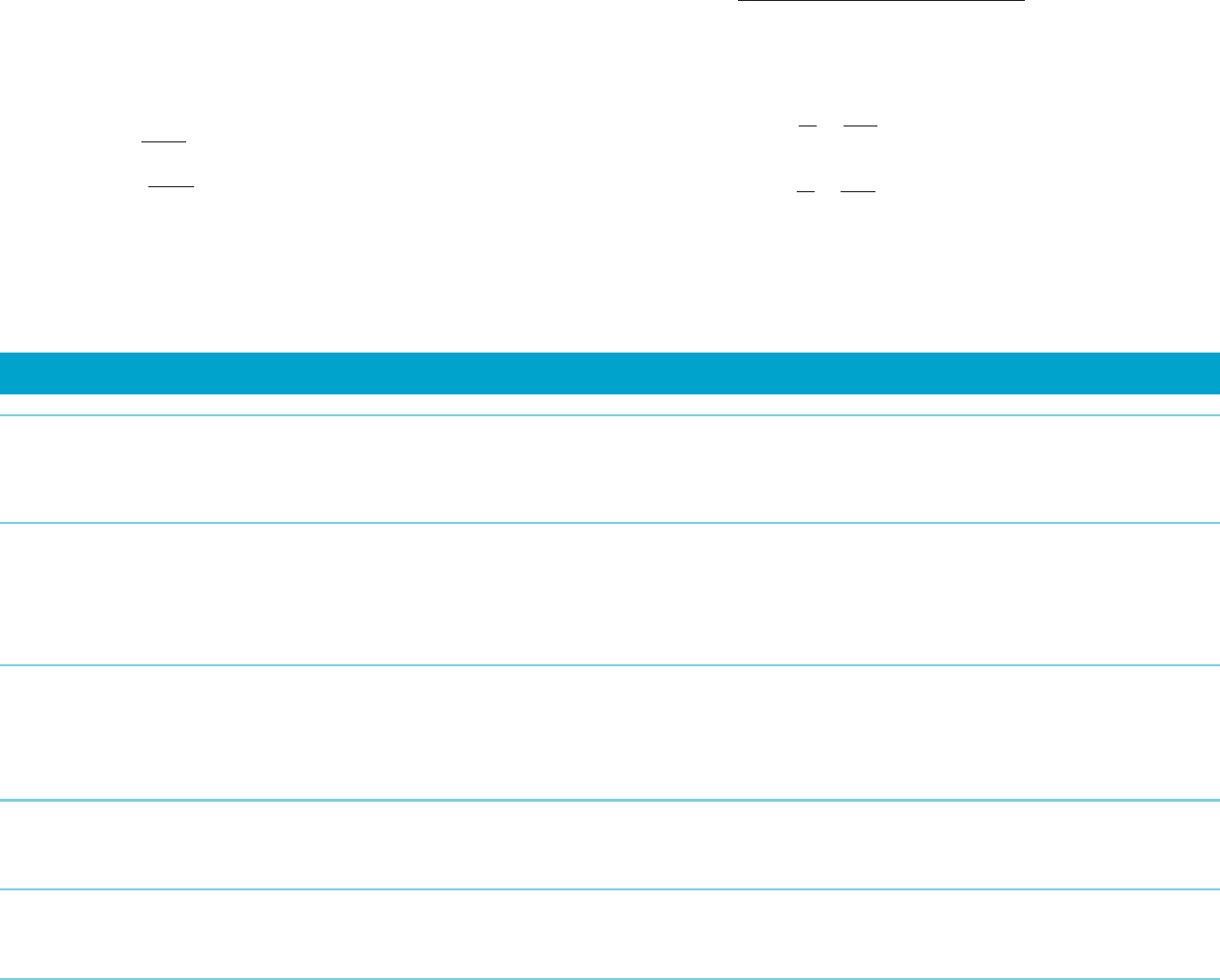Blank B.E., Krantz S.G. Calculus: Single Variable
Подождите немного. Документ загружается.


Proof. Because b is fixed, we may choose an integer ‘ that exceeds b. Notice that
b
k
and k! each have k factors. For k . ‘, we have
b
k
k!
5
b
k
b
ðk 2 1Þ
b
ðk 2 2Þ
b
‘
|fflfflfflfflfflfflfflfflfflfflfflfflfflfflfflfflfflfflfflfflfflffl{zfflfflfflfflfflfflfflfflfflfflfflfflfflfflfflfflfflfflfflfflfflffl}
number less than 1
b
ð‘ 2 1Þ
b
ð‘ 2 2Þ
b
2
b
1
|fflfflfflfflfflfflfflfflfflfflfflfflfflfflfflfflfflfflfflfflfflfflfflfflffl{zfflfflfflfflfflfflfflfflfflfflfflfflfflfflfflfflfflfflfflfflfflfflfflfflffl}
fixed number
: ’
Because the first factor on the right tends to 0 as k tends
to infinity, the proposition
follows.
⁄ EX
AMPLE 7 ( The Power Series Expans ion of the Exponential Function)
Show that e
x
is represented by its Maclaurin series on the entire real line:
e
x
5
X
N
n50
x
n
n!
5 1 1 x 1
1
2!
x
2
1
1
3!
x
3
1
1
4!
x
4
1 ð2N , x , NÞ: ð8:8:12Þ
Solution By
observing that
d
n
dx
n
e
x
5 e
x
and
d
n
dx
n
e
x
j
x50
5 e
x
j
x50
5 1 for every n,we
see that the Taylor polynomial T
N
(x) with base point 0 is
P
N
n50
x
n
=n!,and,the
Taylor series is
P
N
n50
x
n
=n!. In Example 3 of Section 8.5, we used the Ratio Test to
show that this Taylor series is convergent for every real x. Now fix a value of x. Let
J denote the interval between 0 and x. Then,
M 5 max
t2J
d
N11
dt
N11
e
t
5 max
t2J
ðe
t
Þ# e
jxj
:
Theorem 2 tells us that
jR
N
ðxÞj#
M
ðN 1 1Þ!
jxj
N11
# e
jxj
jxj
N11
ðN 1 1Þ!
:
Because x is fixed, Theorem 4 says that the right hand side of this inequality tends
to 0 as N-N. We conclude that lim
N-N
R
N
ðxÞ5 0. This is precisely what is needed
to show that e
x
is equal to its Maclaurin series for every value of x. ¥
INSIGHT
Read Example 7 again to identify the main steps. You will notice that we
use the Taylor expansion of f to generate a power series that we hope converges to f.We
check that it does converge to f by verifying that the remainder term tends to 0. It is not
enough simply to verify that the Taylor series converges for each x. We want to know
that the series converges back to the function f that we began with. To check this, we
must use the error term.
b A LOOK BACK In Example 8 of Section 8.7, we proved that y(x) 5 2 1 2x 1
P
N
n52
x
n
=n! is the solution of the initial value problem dy/dx 5 y 2 x, y(0) 5 2.
We may now simplify the expression for y(x) as follows:
yðxÞ5 2 1 2x 1
X
N
n52
x
n
n!
5 2 1 2x 1
X
N
n50
x
n
n!
21 2 x 5 1 1 x 1
X
N
n50
x
n
n!
5 1 1 x 1 e
x
:
In this explicit form, we can easily verify that y(x) does satisfy the
differential equation dy/dx 5 y 2 x.
8.8 Taylor Series 705

⁄ EXAMPLE 8 Express
f ðxÞ5 xe
22x
2
as a Maclaurin series.
Solution Calcula
ting the Maclaurin series directly from formula (8.8.10) is not
appealing—the derivatives f
(n)
(0) become more and more complicated as n
increases. Instead, we use the known Maclaurin series (8.8.12). It is convenient to
begin with u as the variable:
e
u
5
X
N
n50
u
n
n!
:
Now substitute u 522x
2
to obtain
e
22x
2
5
X
N
n50
ð22 x
2
Þ
n
n!
5
X
N
n50
ð22 Þ
n
x
2n
n!
:
Finally,
xe
22x
2
5 x
X
N
n50
ð22Þ
n
x
2n
n!
5
X
N
n50
ð22Þ
n
x
2n11
n!
5 x 2 2x
3
1 2x
5
2
4
3
x
7
1
2
3
x
9
2
: ¥
⁄ EX
AMPLE 9 (The
Power Series Expansion of the Sine Func tion) Show
that sin(x) is represented by its Maclaurin series on the entire real line:
sinðxÞ5 x 2
x
3
3!
1
x
5
5!
2
x
7
7!
1
x
9
9!
2
x
11
11!
1 2N , x , N: ð8:8:13Þ
Solution The
calculations of Example 2 show that the right side of equation
(8.8.13) is indeed the Maclaurin series of sin(x). We must still sho w that this
Maclaurin series converges to sin(x). Let x be fixed, let J be the interval with
endpoints 0 and x, and let M 5 max
t2J
d
N11
dt
N11
sinðtÞ
. Because
d
N11
dt
N11
sinðtÞ is 6sin(t)
or 6cos(t), we may conclude that M
N 1 1
# 1. Theorem 2 tells us that
jR
N
ðxÞj#
M
ðN 1 1Þ!
jxj
N11
#
jxj
N11
ðN 1 1Þ!
:
Using Theorem 4, we conclude that lim
N-N
R
N
ðxÞ5 0, which is exactly what is
required for equati on (8.8.13) to hold.
b
INSIGHT
Not every property of a function is quickly detected from its power series.
However, because odd powers of x appear in the Maclaurin series of sin(x), we can easily
see that sin(x) is an odd function: sin(2x) 52sin(x). Because we know that cos(x)isan
even function, that is, cos(2x) 5 cos(x) for all x, we expect the Maclaurin series of cos(x)
to involve only even powers of x. Indeed, a calculation that is analogous to that of
Example 9 shows that
cosðxÞ5 1 2
x
2
2!
1
x
4
4!
2
x
6
6!
1
x
8
8!
2
x
10
10!
1 2N , x , N: ð8:8:14Þ
706 Chapter 8 Infinite Series

The Binomial Series Fix a nonzero real number α. Let us expand the function f (x) 5 (1 1 x)
α
about the
point c 5 0. We calculate f
(1)
(x) 5 α(1 1 x)
α21
, f
(2)
(x) 5 α(α 2 1)(1 1 x)
α22
,
f
(3)
(x) 5 α(α 2 1)(α 2 2)(1 1 x)
α23
, and so on. In general, f
(n)
(x) 5 α(α 2 1)
(α 2 2) (α 2 (n 2 1))(1 1 x)
α2n
for n 5 0, 1, 2, . . . . Substituting x 5 0, we obtain
f
ðnÞ
ð0Þ5 αðα 2 1Þðα 2 2Þðα 2 ðn 2 2ÞÞðα 2 ðn 2 1ÞÞ:
The Maclaurin series of f is therefore
X
N
n50
αðα 2 1Þðα 2 2Þðα 2 ðn 2 2ÞÞðα 2 ðn 2 1ÞÞ
n!
x
n
:
There is a useful notation that can be used to simplify the unwieldy appearance of
this Taylor series. For any real number α and nonnegative integer n, we define the
expression
α
n
by
α
0
5 1 and, for a positive integer n,
α
n
5
αðα 2 1Þð α 2 2Þðα 2 ðn 2 2ÞÞðα 2 ðn 2 1ÞÞ
n!
: ð8:8:15Þ
Notice that, when α is a positive integer, equation (8.8.15) is just the same as the
usual definition of the binomial co efficient
α
n
. Using equation (8.8.15), the
Maclaurin series associated to the function f (x) 5 (1 1 x )
α
can be written as
P
N
n50
α
n
x
n
. This series is known as Newton’s binomial series. Its coeffic ients are
known as binomial coefficients, even when α is not a positive integer.
A simple application of the Ratio Test shows that, for every value of α, the
binomial series converges for jxj, 1. For these values of x, the Maclaurin series
converges to the function f :
ð1 1 xÞ
α
5
X
N
n50
α
n
x
n
2 1 , x , 1: ð8:8:16Þ
A proof of this assertion for general α and x in ( 21, 1) is explored in Exercise 79.
⁄ EX
AMPLE 10 Calculate the binomial series for α 5 1/2.
Solution We
have
1=2
0
5 1
1=2
1
5
1=2
1!
5
1
2
1=2
2
5
ð1=2Þð21=2Þ
2!
52
1
8
1=2
3
5
ð1=2Þð21=2Þð23=2Þ
3!
5
1
16
1=2
4
5
ð1=2Þð21=2Þð23=2Þð25=2Þ
4!
52
5
128
:
:::
We conclude that
ð1 1 xÞ
1=2
5 1 1
1
2
x 2
1
8
x
2
1
1
16
x
3
2
5
128
x
4
1
: ð8:8:17Þ ¥
8.8 Taylor Series 707

Using Taylor Series to
Approximate
If a convergent Taylor series is an alternating series, then inequality (8.4.1) can be
used to estimate the remainder. The next two examples illustrate this point.
⁄ EX
AMPLE 11 Approximate
ffiffiffiffiffiffiffiffiffi
1:02
p
to five decimal places.
Solution We
may use the binomial series expansion given by equation (8.8.16) to
obtain
ð1 1 0:02Þ
1=2
5 1 1
0:02
2
2
ð0:02Þ
2
8
1
ð0:02Þ
3
16
2
ð0:02Þ
4
128
1
:
As this is an alternating series, the truncation error is less than the first term that is
omitted. The first term that is less than 5 3 10
26
, the maximum allowable error, is
(0.02)
3
/16 5 5.0 3 10
27
. Our approximation is therefore 1 1 0.02/2 2 (0.02)
2
/8 5
1.00995. A calculator evalua tion yields
ffiffiffiffiffiffiffiffiffi
1:02
p
5 1.0099504 . . . , which confirms our
analysis.
¥
⁄ EXAMPLE 12 Calculate
R
0:3
0
cosðu
2
Þdu to six decimal places.
Solution By
substituting x 5 u
2
in equation (8.8.14), we obtain
cosðu
2
Þ5 1 2
u
4
2!
1
u
8
4!
2
u
12
6!
1
u
16
8!
2
u
20
10!
1
:
Recall that we may integrate a power series term by term in its interval of con-
vergence. Doing so gives us
Z
0:3
0
cosðu
2
Þdu 5
Z
0:3
0
1 2
u
4
2!
1
u
8
4!
2
u
12
6!
1
u
16
8!
2
u
20
10!
1
du
5
u 2
u
5
ð2!Þ5
1
u
9
ð4!Þ9
2
u
13
ð6!Þ13
1
0:3
0
:
It follows that
Z
0:3
0
cosðu
2
Þdu 5 0:3 2
ð0:3Þ
5
ð2!Þ5
1
ð0:3Þ
9
ð4!Þ9
2
ð0:3Þ
13
ð6!Þ13
1
:
By calculating the first few terms of the alternating series on the right side, we find
that the third term, (0.3)
9
/(4! 9), or 9.1125 3 10
28
, is the first that is less than
5 3 10
27
. If we omit it and all subsequent terms, then the error that results is less
than 9.1125 3 10
28
and certainly less than 5 3 10
27
. Thus the approximation
Z
0:3
0
cosðu
2
Þdu 0:3 2
ð0:3Þ
5
ð2!Þ5
5 0:299757
is correct to six decimal places. Software for numerical integration gives us
R
0
0:3
cosðu
2
Þdu 5 0:29975709:::; which confirms our estimate. ¥
Using Taylor
Polynomials to Evaluate
Indeterminate Forms
If a Taylor series of f with base point c is known, then it is often an efficient tool for
calculating an indeterminate form involving f at c. This method is often simpler to
implement than l’Ho
ˆ
pital’s Rule. The ne xt example will illustrate.
708 Chapter 8 Infinite Series

⁄ EXAMPLE 13 Evaluate
lim
x-0
arctanðx
2
Þ
1 2 cosðxÞ
:
Solution The
requested limit is indeterminate of form
0
0
. From (8.7.3b) and
(8.8.14), we have
lim
x-0
arctanðx
2
Þ
1 2 cosðxÞ
5 lim
x-0
ðx
2
Þ2
1
3
ðx
2
Þ
3
1
1
5
ðx
2
Þ
5
2
x
2
2!
2
x
4
4!
1
x
6
6!
2
5 lim
x-0
x
2
1 2
1
3
x
4
1
1
5
x
8
2
x
2
1
2
2
x
2
4!
1
x
4
6!
2
5 lim
x-0
1 2
1
3
x
4
1
1
5
x
8
2
1
2
2
x
2
4!
1
x
4
6!
2
5
1
1=2
5 2:
QUICK QUIZ
1. What is the coefficient of x
12
in the Maclaurin series of sin(x)?
2. What is the coefficient of x
6
in the Maclaurin series of cos(x)?
3. What is the coefficient of x
n
in the Maclaurin series of e
x
?
4. What is the order 2 Taylor polynomial with base point 0 of 1=
ffiffiffiffiffiffiffiffiffiffiffi
1 1 x
p
?
Answers
1. 0 2. 21/720
3. 1/n!4.12 x/2 1 3x
2
/8
EXERCISES
Problems for Practice
c In each of Exercises 1212, approximate f (x) at the indi-
cated value of x by using a Taylor polynomial of given order
N and base point c. Use formula (8.8.3) of Theorem 1 to
express the error resulting from this approximation in terms
of a number s between c and x. b
1. f ðxÞ5 e
x
x 5 0:1 N 5 4 c 5 0
2.
f ðxÞ5 e
2x
x 520:01 N 5 3 c 5 0
3. f ðxÞ5 sinðxÞ x 5 0:3 N 5 5 c 5 0
4. f ðxÞ5 sinðxÞ x 5 1:6 N 5 5 c 5 π=2
5. f ðxÞ5 cosðxÞ x 5 0:5 N 5 2 c 5 π=6
6. f ðxÞ5 cosðxÞ x 520:85 N 5 3 c 52π=4
7. f ðxÞ5 lnðxÞ x 5 3 N 5 3 c 5 e
8. f ðxÞ5 lnðxÞ x 5 1:2 N 5 4 c 5 1
9. f ðxÞ5 arctanðxÞ x 5 1:5 N 5 2 c 5
ffiffi
ffi
3
p
10.
f ðxÞ5 1=
ffiffiffi
x
p
x 5 3:9 N 5 3 c 5 4
11.
f ðxÞ5
ffiffiffiffiffiffiffiffiffiffiffi
1 1 x
p
x 5 3:2 N 5 2 c 5 3
12.
f ðxÞ5
ffiffi
ffi
x
p
x 5 24:4 N 5 3 c 5 25
c In each of Exercises 13222, a function f,
an order N,a
base point c, and a point x
0
are given. The interval with
endpoints c and x
0
is denoted by J. b
a. Calculate
the approximation T
N
(x
0
)off (x
0
).
b. By showing that M 5 max
t 2J
jf
(N 1 1)
(t)j is the greater
of jf
(N 1 1)
(c)j and jf
(N 1 1)
(x
0
)j, and by using inequality
(8.8.7) of Theorem 2, find an upper bound for the
absolute error jR
N
(x
0
)j5 jf (x
0
) 2 T
N
(x
0
)j that results
from the approximation of part a.
13. f (x) 5
ffiffiffiffiffiffiffiffiffiffiffi
1 1 x
p
N 5 3 J 5 [c, x
0
] 5 [0, 0.4]
14. f (x) 5 x 1 sin(x) N 5 3 J 5 [x
0
, c] 5 [ π6, π/4]
15. f (x) 5 sin(x
2
2 1) N 5 2 J 5 [x
0
,c]5 [0.9, 1]
16. f (x) 5 x 1 e
x
N 5 3 J 5 [c, x
0
] 5 [0, 0.8]
17. f (x) 5 x
2
1 e
11x
N 5 2 J 5 [x
0
, c] 5 [ 21.2, 21]
18. f (x) 5 x/(1 1 x) N 5 2 J 5 [c, x
0
] 5 [0, 0.5]
19. f (x) 5 ln(x) N 5 2 J 5 [x
0
, c] 5 [2.5, e]
20. f (x) 5 ln(1 1 x
2
) N 5 2 J 5 [c, x
0
] 5 [0, 0.4]
21. f (x) 5 arctan(x) N 5 2 J 5 [c, x
0
] 5 [0, 0.4]
22. f (x) 5 1/(1 1 x
2
) N 5 2 J 5 [c, x
0
] 5 [0, 0.2]
c In each of Exercises 23234, derive the Maclaurin series of
the
given function f (x) by using a known Maclaurin series. b
23. f (x) 5 sin(2x)
24. f (x) 5 x cos(x)
25. f (x) 5 x
2
sin(x/2)
26. f (x) 5 x
3
1 cos(x
2
)
8.8 Taylor Series 709

27. f (x) 5 5 cos(2x) 2 4sin(3x)
28. f (x) 5 e
12x
29. f (x) 5 exp(2x
2
)
30. f (x) 5 x
2
/(1 2 x)
31. f (x) 5 x/(1 1 x
2
)
32. f (x) 5 ln(1 1 x
2
)
33. f ðxÞ5
ffiffiffiffiffiffiffiffiffiffiffiffiffi
1 1 x
3
p
34. f ðxÞ5 1=
ffiffiffiffiffiffiffiffiffiffiffiffiffi
1 2 x
2
p
c In Exercises 35242, use formula (8.8.10) with the given
base
point c to compute the Taylor series of the given func-
tion f. b
35. f ðxÞ5
ffiffi
ffi
x
p
c 5 1 (See Exercise 91, Section 8.1)
36. f ðxÞ5
ffiffiffi
x
p
c 5 4 (See Exercise 91, Section 8.1)
37. f (x) 5 xe
x
c 5 1
38. f (x) 5 1/xc5 2
39. f (x) 5 ln(x) c 5 1
40. f (x) 5 2
x
c 5 2
41. f (x) 5 3
2x
c 523
42. f (x) 5 x ln(x) c 5 1
c In each of Exercises 43248, write Newton’s binomial series
fo
r the given expression up to and including the x
3
term. b
43. (1 1 x)
3/4
44. (1 1 x)
4
45. 1/
ffiffiffiffiffiffiffiffiffiffiffi
1 1 x
p
46. 1/(1 1 x)
47. 1/(1 1 x)
3/2
48. 1/(1 1 x)
2
c In each of Exercises 49254, use Taylor series to calculate
the given limit. b
49. lim
x-0
sinðxÞ2 x
x
3
50. lim
x-0
1 2 cosðxÞ
x
2
51. lim
x-0
lnð1 1 xÞ2 x
x
2
52. lim
x-0
arctanðxÞ2 x
x
3
53. lim
x-0
1 2 e
2x
x
54. lim
x-0
e
x
2 e
2x
x
Further Theory and Practice
c In each of Exercises 55260, use Taylor series to calculate
the given limit. b
55. lim
x-0
cosðxÞ2 expð2x
2
Þ
x
2
56. lim
x-0
e
3x
2 e
23x
2 6x
x
3
57. lim
x-0
arctanðxÞ2 sinðxÞ
x
1 2 cosðxÞ
58. lim
x-0
sinðxÞ2 x
1 2 cosðxÞ
lnð1 1 xÞ
59. lim
x-0
cos
2
ðxÞ2 expðx
2
Þ
xsinðxÞ
60. lim
x-0
lnð1 1 2x
2
Þ
e
3x
2 3x 2 cosðxÞ
61. Use Half Angle Formula (1.6.10) to find the Maclaurin
series of sin
2
(x).
62. Use Half Angle Formula (1.6.11) to find the Maclaurin
series of cos
2
(x).
63. Use the Maclaurin series found in Exercise 61 to evaluate
lim
x-0
sin
2
ðxÞ2 sinðx
2
Þ
x
4
:
64. Use the Maclaurin series for exp(x) to calculate
lim
x-0
sinhð3xÞ2 tanhð3xÞ
xðcoshð2xÞ2 sechð2xÞÞ
:
65. Suppose that f v is continuous on an open interval cen-
tered at c. Use Taylor’s Theorem to show that
lim
h-0
f ðc 1 hÞ2 2f ðcÞ1 f ðc 2 hÞ
h
2
5 f vðcÞ:
c In each of Exercises 66271, evaluate the given series
(exactly). b
66.
π
4
2
π
3
4
3
3!
1
π
5
4
5
5!
2
π
7
4
7
7!
1
67. 1 2
π
2
3
2
2!
1
π
4
3
4
4!
2
π
6
3
6
6!
1
π
8
3
8
8!
2 :::
68. 1 2
π
2
2
2
3!
1
π
4
2
4
5!
2
π
6
2
6
7!
1
69. 1 1
1
1!
1
1
2!
1
1
3!
1
1
4!
1
70. 1 2
1
1!
1
1
2!
2
1
3!
1
1
4!
2
:::
71.
2
1!
1
4
2!
1
8
3!
1
16
4!
1
32
5!
1
72. Find the Maclaurin series of cosh(x) and sinh(x).
73. Use the Maclaurin series of cos(x), namely 1 1 u where
u 5
P
N
m51
ð21Þ
n
x
2n
=ð2nÞ!; and the Maclaurin series
P
N
m51
ð21Þ
m11
u
m
=m of ln(1 1 u), to show that the
Maclaurin series of ln(cos(x)) is 2 x
2
/2 2 x
4
/12 2 x
6
/45 2
. . . . Use this result to obtain the Maclaurin series of tan
(x) up to and including the x
5
term.
74. Derive the Maclaurin series expansion
ln
1 1 x
1 2 x
5 2x 1
2x
3
3
1
2x
5
5
1
2x
7
7
1
;
which is valid for 21 , x , 1. Use this expansion to estimate
ln(2) to five decimal place accuracy. The series used here is
more rapidly convergent than the more familiar series
710 Chapter 8 Infinite Series

lnð2Þ5 1 2
1
2
1
1
3
2
1
4
1
1
5
2
::::
75. Show that
21=2
n
5
ð21Þ
n
ð2nÞ!
2
2n
ðn!Þ
2
:
Using this formula, state the Maclaurin series of
(1 1 u)
21/2
, and derive the Maclaurin series of arcsin(x).
76. Show that the Taylor series of f (x) 5 x
2
e
x
with base point
1is
X
N
n50
ðn
2
1 n 1 1Þ
n!
e ðx 2 1Þ
n
:
77. Let f (t) 5 tan(t/3) 1 2 sin(t/3). Snell’s Inequality, dis-
covered in 1621, states that t # f (t) for 0 , t , 3π/2. The
approximation t f (t) is remarkably good for 0 , t , π/2.
Calculate the Taylor polynomial of degree 5 for f about
c 5 0. Use it to explain the accuracy of the approximation.
78. The inequality
3 sinðtÞ
2 1 cosðtÞ
, t ðfor all t . 0Þ
was discovered by Nicholas Cusa in 1458. Calculate the
Taylor polynomial of degree 5 for f (t) 5 3sin(t)/(2 1 cos(t))
about c 5 0. Use it to explain Cusa’s inequality for small
positive values of t.
79. Fix a nonzero real number α. Define f (x) 5 (1 1 x)
α
and
gðxÞ5
X
N
n50
α
n
x
n
:
Our goal is to show that f (x) 5 g(x) for x 2 (21, 1). We
know from the text that the series certainly converges on
that interval. Now complete the following steps:
a. Prove that
ðn 1 1Þ
α
n 1 1
1 n
α
n
5 α
α
n
:
b. Prove that
ð1 1 xÞguðxÞ5 α gðxÞ; x 2ð21; 1Þ:
c. Prove that
ð1 1 xÞf uðxÞ5 α f ðxÞ; x 2ð21; 1Þ:
d. Notice
that f (0) 5 g(0) 5 1.
e. Solve the equation (1 1 x)yu 5 α y by rewriting it as
yu
y
5
α
1 1 x
:
f. Find the unique solution to the equation (1 1 x)yu 5
α y satisfying y(0) 5 1. Conclude that f 5 g.
80. Suppose that f is twice continuously differentiable in an
open interval I that is centered at c. Let x be any fixed
point in I. Consider the function
φðtÞ5 f ðxÞ2 f ðtÞ2 ðx 2 tÞf uðtÞ2
x 2 t
x 2 c
2
f ðxÞ2 T
1
ðxÞ
for c , t , x. Apply Rolle’s Theorem to ϕ to deduce that
there is a s between c and x for which ϕ
(1)
(s) 5 0. Con-
clude that
f ðxÞ5 T
1
ðxÞ1
f
ð2Þ
ðsÞ
2
ðx 2 cÞ
2
for some s between c and x.
81. Suppose that f is N times continuously differentiable in an
open interval I that is centered at c. Let x be any fixed
point in I. Define the function
ρ
N
ðtÞ5 f ðxÞ2
X
N
n50
f
ðjÞ
ðtÞ
n!
ðx 2 tÞ
n
for c , t , x. Let
ϕðtÞ5 ρ
N
ðtÞ2
x 2 t
x 2 c
N11
ρ
N
ðcÞ:
Note that ϕ(c) 5 ϕ( x) 5 0. Apply Rolle’s Theorem to ϕ to
deduce that there is a s between c and x for which
ϕ
(1)
(s) 5 0. Deduce Taylor’s Theorem from this fact.
Calculator/Computer Exercises
c In each of Exercises 82285, use an alternating Maclaurin
series to approximate the given expression to four decimal
places. b
82. cos(0.2)
83. sin(0.3)
84. exp(20.2)
85. arctan(0.15)
86. Us
e a Taylor polynomial with base point c 5 e
3
to
approximate ln(20) to five decimal places. Do not use a
calculator to evaluate any value of ln(x), but you may use a
calculator for arithmetic with the number e and its powers.
c In each of Exercises 87290, a function f,
a base point c,
and a number x
0
are given. In the ty-plane, plot the horizontal
line y 5 f (x
0
) 2 T
3
(x
0
) and the graph of y 5 f
(4)
(t) (x
0
2 c)
4
/4!
for t between c and x
0
. Use your graph to determine a value of
s for which equation (8.8.3) holds. b
87. s 5 f (x) 5
ffiffiffiffiffiffiffiffiffiffi
ffi
3 1 x
p
c 5 1 x
0
5 1.4
88. f (x) 5 x2
2x
c 5 2 x
0
5 1.7
89. f (x) 5 sin(x/2) 23 cos(x) c 5 π x
0
5 3.5
90. f ðxÞ5
x
2
1 1
x 1 2
c 5 3 x
0
5 2.6
c In each of Exercises 91294 afunctionf,ab
asepointc,anda
point x
0
are given. Plot y 5 j f
(3)
(t)j for t between c and x
0
.Use
your plot to estimate the quantity M of Theorem 2. Then use
your value of M to obtain an upper bound for the absolute error
jR
2
(x
0
)j5 jf (x
0
) 2 T
2
(x
0
)j that results when f (x
0
)isapproxi-
mated by the order 2 Taylor polynomial with base point c. b
91. f (x) 5 x sin(x) c 5 π/6 x
0
5 0.6
8.8 Taylor Series 711

92. f (x) 5 ln(2x
2
2 1) c 5 1 x
0
5 1.3
93. f (x) 5
ffiffiffiffiffiffiffiffiffiffiffiffiffiffiffi
16 1 x
2
p
c 5 3 x
0
5 2.4
94. f (x) 5 e
sin(x)
c 5 0 x
0
5 0.4
c In Exercises 95298, use a Taylor polynomial to calculate
the
given integral to five decimal places. b
95.
R
1=2
0
e
2x2
dx
96.
R
π=4
0
sinðxÞ
x
dx
97.
Z
1=3
0
1
1 1 x
5
dx
98.
R
1=2
0
ffiffiffiffiffiffiffiffiffiffiffiffiffi
1 1 x
3
p
dx
99. Plot
f ðxÞ5
sin
tanðxÞ
2 tan
sinðxÞ
arcsin
arctanðxÞ
2 arctan
arcsinðxÞ
for 0.01 , x , 0.02. If your plot did not come out cor-
rectly, then the following considerations may help. The
numerator of f (x) has Maclaurin series
2
x
7
30
2
29x
9
756
1
and the denominator has Maclaurin series
2
x
7
30
1
13x
9
756
1
:
Use these two series to plot f in the given interval.
Summary of Key Topics in Chapter 8
Series
(Section 8.1)
An infinite sum
P
N
n51
a
n
is called a series. (Sometimes it is convenient to begin a
series at an index other than n 5 1.) The expression S
N
5
P
N
n51
a
n
is called the N
th
partial sum of the series. The series is said to converge to a limit ‘ if S
N
-‘ as N-N.
Some Special Series
(Section 8.1, Section 8.2)
The harmonic series
P
N
n51
1=n diverges.
The geometric series
P
N
n5M
r
n
with ratio r converges if and only if jrj, 1. When
jrj, 1, the series sums to r
M
/(1 2 r). Here M can be any integer.
The p-series
P
N
n51
1=n
p
converges if and only if p . 1.
Properties of Series
(Section 8.1)
If
P
N
n51
a
n
converges to A and
P
N
n51
b
n
converges to B, then
a.
P
N
n51
ða
n
1 b
n
Þ5 A 1 B;
P
N
n51
ða
n
2 b
n
Þ5 A 2 B:
b.
P
N
n51
λa
n
5 λA for any real constant λ.
The Divergence Test
(Section 8.2)
If
P
N
n51
a
n
converges, then a
n
- 0. Equivalently, if the summands of a series do not
tend to 0 then the series cannot converge.
The Integral Test
(Section 8.2)
Let f be
a positive, continuous, decreasing function with domain {x :1# x ,N}.
Then
R
N
1
f ðxÞdx converges if and only if
P
N
n51
f ðnÞ converges.
The Comparison Tests
(Section 8.3)
If 0 # a
n
# b
n
and
P
N
n51
b
n
converges, then
P
N
n51
a
n
converges.
If 0 # b
n
# a
n
and
P
N
n51
b
n
diverges, then
P
N
n51
a
n
diverges.
Let
P
N
n51
a
n
and
P
N
n51
b
n
be series of positive terms. Suppose that lim
n-N
a
n
/b
n
exists as a (finite) positive number. Then
P
N
n51
a
n
converges if and only if
P
N
n51
b
n
converges.
712 Chapter 8 Infinite Series

Alternating Series Test
(Section 8.4)
If a
1
$ a
2
$ a
3
$ . . . and if lim
n-N
a
n
5 0, then
P
N
n51
(21)
n11
a
n
converges.
Series with Positive
and Negative Terms
(Section 8.4)
A series
P
N
n51
a
n
is said to converge absolutely if
P
N
n51
ja
n
j converges.
If a series converges absolutely, then it converges.
A series that is convergent but not absolutely converge nt is called conditionally
convergent.
The Ratio and Root
Tests
(Section 8.5)
The Ratio Test:
Let
P
N
n51
a
n
satisfy lim
n-N
ja
n11
/a
n
j5 ‘.If‘ , 1, then the series
converges absolutely. If ‘ . 1, then the series diverges. If ‘ 5 1, then no conclusion
is possible from the Ratio Test.
The Root Test: Let
P
N
n51
a
n
satisfy lim
n-N
ja
n
j
1/n
5 ‘.If‘ , 1, then the series con-
verges absolutely. If ‘ . 1, then the series diverges. If ‘ 5 1, then no conclusion is
possible from the Root Test.
Power Series and
Radius of
Convergence
(Section 8.6)
An expression
X
N
n50
a
n
ðx 2 cÞ
n
is called a power series with base point c (or center c). We set ‘ 5 lim
n-N
ja
n
j
1/n
,
provided that this limit exists as a finite or infinite number. If it is convenient, then
the formula ‘ 5 lim
n-N
ja
n11
j/ja
n
j may be used instead. The number R 5 1/‘ is called
the radius of convergence of the power series (with the understanding that R 5 0
when ‘ 5 N,andR 5N when ‘ 5 0). The power series will converge absolutely for
jx 2 cj, R and diverge for jx 2 c j. R.Theinterval of convergence of a power series
is the set of points at which the series is convergent. If R is a positive finite number,
then the interval of convergence will be (c 2 R, c 1 R), [c 2 R, c 1 R), (c 2 R, c 1 R],
or [c 2 R, c 1 R]. If R is infinite, then the interval of convergence is the entire real
line. If R 5 0, then the interval of convergence is just the point c.
Basic Properties of
Power Series
(Section 8.6)
Theorem:
In the interval of convergence,
X
N
n50
ða
n
1 b
n
Þx
n
5
X
N
n50
a
n
1
X
N
n50
b
n
;
X
N
n50
ða
n
2 b
n
Þx
n
5
X
N
n50
a
n
2
X
N
n50
b
n
;
and
X
N
n50
λa
n
x
n
5 λ
X
N
n50
a
n
x
n
for every λ 2 R:
Theorem: Power series may be differentiated and integrated term by term in the
interior of the interval of convergence.
Theorems 1 and 2 may be used to generate convergent power series expansions
for several functions.
Expanding Functions
in Power Series
(Section 8.7)
The geometric series with ratio x can
be regarded as a power series for its sum:
1
1 2 x
5
X
N
n50
x
n
5 1 1 x 1 x
2
1 x
3
1 for 21 , x , 1:
Summary of Key Topics 713

This basic power series leads to other power series expansions through substitution
and integration. Examples include
lnð1 1 xÞ5
X
N
n51
ð21Þ
n21
n
x
n
5 x 2
1
2
x
2
1
1
3
x
3
2
1
4
x
4
1
1
5
x
5
2
1
6
x
6
1
1
7
x
7
2
:::
for 21 , x , 1
and
arctanðxÞ5
X
N
n50
ð21Þ
n
x
2n11
2n 1 1
5 x 2
1
3
x
3
1
1
5
x
5
2
1
7
x
7
1
1
9
x
9
2 for 21 , x , 1:
The Relationship
between the
Coefficients and
Derivatives of a Power
Series
(Section 8.7)
If a power series
P
N
n50
a
n
(x 2 c )
n
converges on an open interval I centered at c,
then the function f defined by f (x) 5
P
N
n50
a
n
(x 2 c)
n
is infinitely differentiable on I
and
a
n
5
f
ðnÞ
ðcÞ
n!
for every natural number n.
Taylor Series and
Taylor Polynomials
(Section 8.7)
If f is
infinitely differentiable on an interval centered about a point c , then the
power series
TðxÞ5
X
N
n50
f
ðnÞ
ðcÞ
n!
ðx2cÞ
n
can be defined. It is called the Taylor series of f with base point c. A Taylor series
with base point 0 is also called a Maclaurin series. If a power series converges to f,
then it must be a Taylor series. The converse is not alway s true: A Taylor series
T(x)off need not converge to f (x )ifx is not the base point. A polynomial of
the form
T
N
ðxÞ5
X
N
n50
f
ðnÞ
ðcÞ
n!
ðx 2 cÞ
n
is called an order N Taylor polynomial of f with base point c.
Taylor’s Theorem with
Remainder
(Section 8.8)
If f is N 1 1
times continuously differentiable on an interval I centered at c, then,
for any x 2I, we have
f ðxÞ5
X
N
n50
f
ðnÞ
ðcÞ
n!
ðx 2 cÞ
n
|fflfflfflfflfflfflfflfflfflfflfflfflfflfflfflffl{zfflfflfflfflfflfflfflfflfflfflfflfflfflfflfflffl}
T
N
ðxÞ
1
f
ðN11Þ
ðsÞ
ðN 1 1Þ!
ðx 2 cÞ
N11
|fflfflfflfflfflfflfflfflfflfflfflfflfflfflfflfflffl{zfflfflfflfflfflfflfflfflfflfflfflfflfflfflfflfflffl}
R
N
ðxÞ
for some s between c and x. We call R
N
the remainder term or error term of
order N.
714 Chapter 8 Infinite Series
